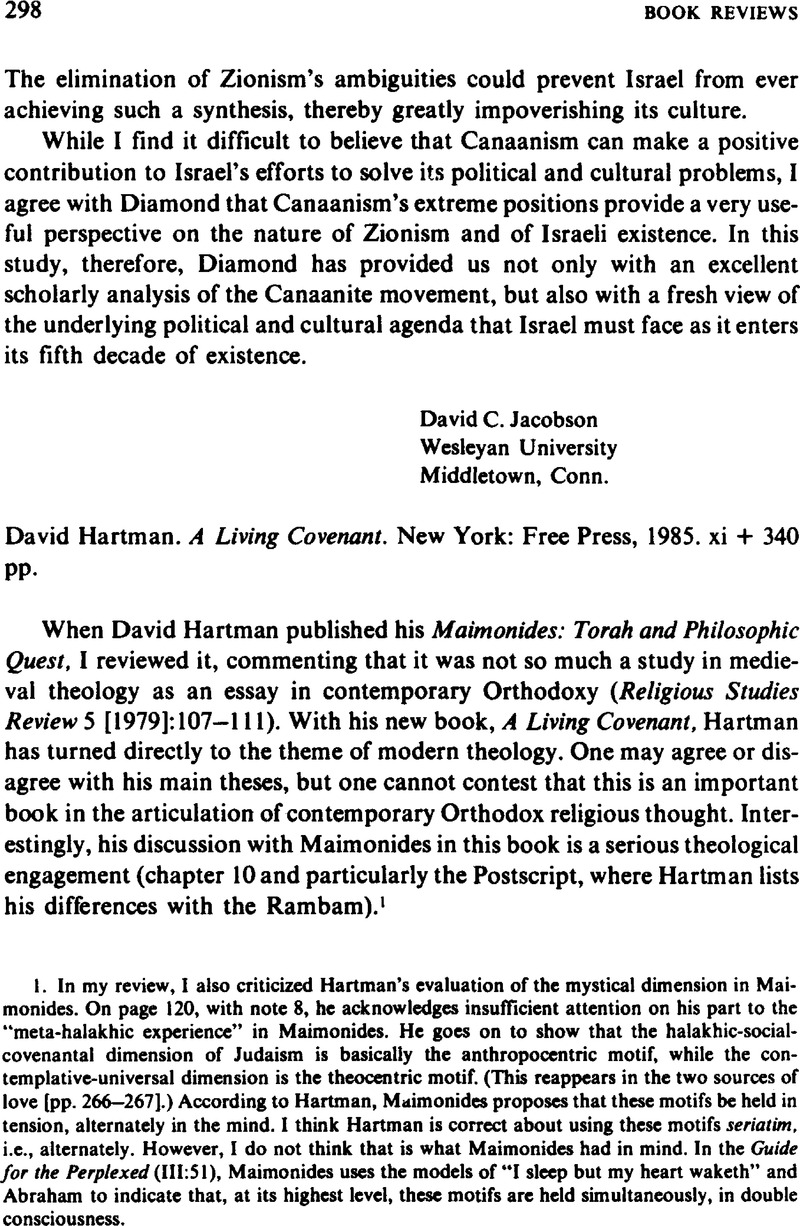No CrossRef data available.
Published online by Cambridge University Press: 15 October 2009

1. In my review, I also criticized Hartman′s evaluation of the mystical dimension in Maimonides. On page 120, with note 8, he acknowledges insufficient attention on his part to the “meta-halakhic experience” in Maimonides. He goes on to show that the halakhic-socialcovenantal dimension of Judaism is basically the anthropocentric motif, while the contemplative- universal dimension is the theocentric motif. (This reappears in the two sources of love [pp. 266–267].) According to Hartman, Maimonides proposes that these motifs be held in tension, alternately in the mind. I think Hartman is correct about using these motifs seriatim, i.e., alternately. However, I do not think that is what Maimonides had in mind. In the Guide for the Perplexed (IH:S1), Maimonides uses the models of “I sleep but my heart waketh” and Abraham to indicate that, at its highest level, these motifs are held simultaneously, in double consciousness.
2. This is best illustrated in the shocking midrash on Exod. 32:10: “Now therefore let Me alone, that My wrath may grow hot against them...‘ Rabbi Abbahu said,’... This teaches that Moses took hold of the Holy One, blessed be He, like a man who seizes his fellow by the garment...’” (p. 54).
3. Three other ideas deserve special note: first, that the ethical defines the halakhic (pp. 99–100); second, that the uniqueness of the Jewish people is normative, not ontological (p. 105); and third, that the relational intimacy of prayer grows out of the normative life of Judaism, not out of the mystical, the ecstatic, or the prophetic (p. 149). This is a very rich book.
4. Hartman′s book was reviewed at length by D. Landes in Tikkun 1, no. 2 (1987): 106–1II. Hartman replied and Landes had a last word in Tikkun 2, no. 1 (1987): 121–126. For Hartman on anthropology and not metaphysics, cf. ibid., p. 124.
5. Ibid., p. 123.
6. Cf. D. Blumenthal, “Mercy,” in Contemporary Jewish Religious Thought, ed. A. Cohen and P. Mendes-Flohr (New York: Scribner′s, 1987), pp. 589–596.
7. I agree with Landes (Tikkun 1, p. I l l ) that Hartman does not deal adequately with chosenness. Cf., however,Google ScholarWyshogrod, M., The Body of Faith: Judaism as Corporeal Election (New York: Seabury Press, 1983), reviewed by me in AJS Review 11, no. 1 (Spring 1986): 116–121.Google Scholar